
 |
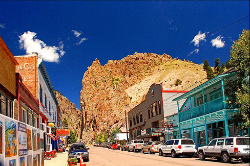 |
Creede Creede was the last silver boom town in Colorado in the 1800s. The town leapt from a population of 600 in 1889 to more than 10,000 people in December 1891. The Creede mines operated continuously from 1890 until 1985. |
|||
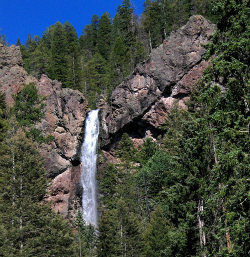 |
Treasure Falls On Fall Creek on Route 160, west of Wolf Creek Pass you'll find this impressive waterfall. There is a well maintained trail that will take you close to the base of the falls. It is about a 3/4 mile hike with about 800' elevation gain. Plan an hour or so for the hike. |
|||
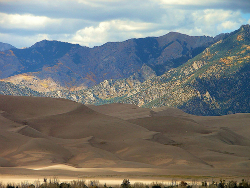 |
Sand Dunes national monument On the eastern side of the remote, high-mountain San Luis Valley, between the Blanca Massif and Crestone Needle, are the Great Sand Dunes, the tallest sand dunes in North America. The dunes cover approximately 39 square miles and rise to almost 750' above the valley floor. The dunes are the product of the wind and rain eroding the San Juan and Sangre de Cristo Mountains that ring the San Luis Valley. They have collected here because the prevailing winds across the valley blow in this direction and meet winds blowing in the opposite direction. |
|||
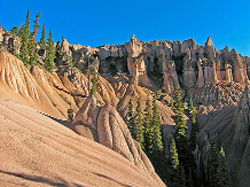 |
Wheeler National Monument Wheeler Geologic Area is a beautiful demonstration of a landscape that is rapidly evolving into a truly unique panorama. 30 million years ago, the moderately coarse volcanic tuff that makes up the surface layer of the area was blown into the atmosphere by the explosion of the La Garita Caldera, near Creede. What we are left with is an incredibly picturesque badlands of spires and pinnacles with extremely steep slopes that make this area almost impossible to traverse. |
|||
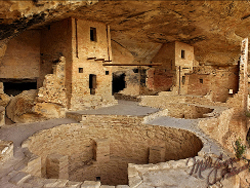 |
Mesa Verde National Monument Mesa Verde, Spanish for green table, offers a spectacular look into the lives of the Ancestral Pueblo people who made it their home for over 700 years, from A.D. 600 to A.D. 1300. Today, the park protects over 4,000 known archeological sites, including 600 cliff dwellings. These sites are some of the most notable and best preserved in the United States. |
|||
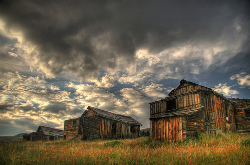 |
Summitville This ghost town is located in the San Juan mountains. The town sits at about 11,800 feet and was first mined about 1870. A stampede from Del Norte developed in the early 1870's after a miner showed a piece of float gold in a local bar. By 1886 there were at least fourteen saloons operating in town. |
|||
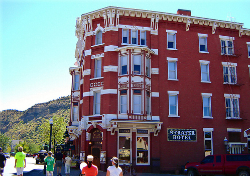 |
Durango Durango is nestled in the Animas River Valley surrounded by the San Juan Mountains. The Animas River - El Río de las Animas Perdidas or the River of Lost Souls - runs through downtown and boasts gold medal fly fishing waters and is very popular for whitewater rafting, kayaking and canoeing. Durango is an outdoor activity paradise - Hiking, mountain biking, road biking, backpacking, rock climbing, hunting, off-roading, year-round fishing, kayaking, rafting and golfing - to name just a few. |
|||
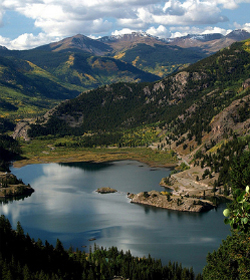 |
Lake City The people who come to Lake City end up |
|||
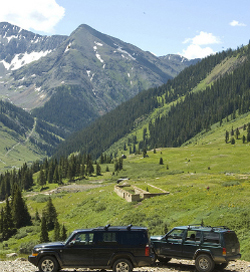 |
THE ALPINE LOOP The Loop is at the heart of the jagged San Juan Mountains. The drive takes you above tree line and over Engineer Pass and Cinnamon Pass, each over 12,000 feet in elevation. Along the way, you will see the ghost town relics of the mining boom of the late 1800s, including cabins, mills, and mine sites. There are interpretive signs along the way that explain the significance of this road to the development of the American West. |
|||
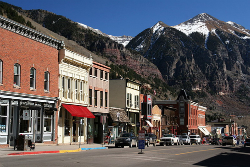 |
Telluride Amenities |
|||
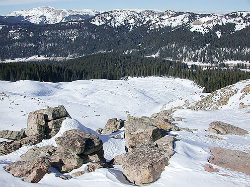 |
Wolf creek Ski Area Located on the Wolf Creek Pass between Pagosa Springs and South Fork. It is best known for receiving more average annual snowfall than any other resort in Colorado, at about 435 inches per year. |
|||
 |
Wheeler National Monument 30 million years ago, the moderately coarse volcanic tuff that makes up the surface layer of the area was blown into the atmosphere by the explosion of the La Garita Caldera, near Creede. Individual particles of this tuff vary from dust flakes to blocks two and three feet across. As none of this surface layer is compacted or cemented together, the beds readily erode. What we are left with is an incredibly picturesque badlands of spires and pinnacles with extremely steep slopes that make this area almost impossible to traverse. |
|||
Phone: (May - October) 719 873 5216 - (November - April) 928-342-3069 | Email: lleedie@yahoo.com |